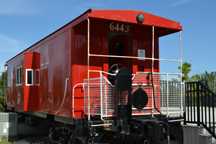|
Railroads that forged down the coasts of Florida’s peninsula in the late 19th
century were no doubt the primary means of progress in a quest to
civilize an inhospitable periphery attractive mostly to hardened
adventurers and desperados hiding from the law. Roads—mostly primitive
trails—attempted with difficulty to route the few travelers around the
unpleasantness while the railroads arrowed straight ahead without
deviation from geography or objective.
The
rails directed to Venice were of a later more experienced era, but just
as important in the development of this particular coastal city. By
1903 the US and West Indies Railroad and Steamship Company, a subsidiary
of the Seaboard Air Line Railroad had extended its reach as far south
as Sarasota. After eight years of complacency, Bertha Honore Palmer, a
shrewd businesswoman and international socialite (think Chicago’s Palmer
House), convinced the railroad to unfurl its influence another 16.5
miles to what seemed an immature market. She named the terminal Venice.
With
the easy transport of people and freight, Venice grew but remained a
fishing and farming community into the ‘20s, but was prime for
expansion. In 1925 the Brotherhood of Locomotive Engineers purchased
acreage with the intent of building a terminal with a large capacity for
growth, and it should be said, to benefit their union’s assets.
The
Brotherhood of Locomotive Engineers also formed a realty company and
retained renowned city planner John Nolan to guide the burgeoning city.
The terminal’s Mediterranean Revival style—consistent with Nolan’s
citywide plan—resulted in an embellishment, both architecturally and
historically significant. And since 1989, it has been listed in the U.S.
National Register of Historical places.
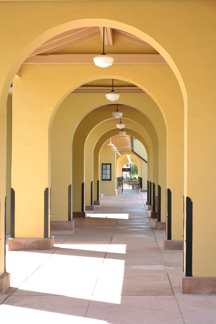
Arches along the tracks.
Completed
in 1927, the structure, 50 feet wide and 400 feet long was much more
extravagant than function demanded. More than just a service point, it
was intended to be an attraction for prospective newcomers.
Unfortunately a year later the bottom fell out of the Florida real
estate boom, and Venice began to resemble less a metropolis, than a
ghost town.
The
depot, however, still served as an appealing entry to the area; an
access that shaped the arrival of three institutions—none of which would
have succeeded without the rail expediency—that helped revitalize the
city.
In
1932 the Kentucky Military Institute found Venice desirable as winter
headquarters, and remained for nearly forty years. During WW II the Army
Air Corp determined Venice was a perfect base for training, and
beginning in 1960, for more than thirty years, the Ringling Brothers AndBarnum & Bailey Circus used Venice as their winter headquarters.
Eventually,
however, all rail activity came to a halt. The last passenger train
left the depot in 1971, and the tracks began to rust from disuse after
the final freight shipment in 1997.
After
years of neglect, city and county authorities realized that this icon
of one of America’s past great industries should be preserved.
Subsequently the county, for restoration, acquired the depot—the last
remaining in Sarasota County—with the dedication coming in October of
2003.
Today
the Depot seems as much a salute to the city’s history and the
building’s architectural lavishness than to railroading—and why not? It
is after all a symbol of accomplishment, exhumed and restored to glory
at a cost of $2.3 million.
The
entry is bedecked with large informational placards and photo reminders
of the city’s past—accompanied by displays of related relics of the
period and commerce.
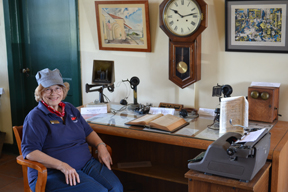
Barbara Smith, Historic Venice Depot docent and President of the Historical Society
In
another room, are artifacts of railroading in its heyday. There is a
restored handcar sometimes known as a pump car, jigger, or Kalamazoo
that was used mainly for maintenance work. There are also lanterns, hand
tools, and other paraphernalia used by workers. The original station
agent’s desk is equipped with the now-antique tools of his trade when
everything was done manually, and the original ticket window through
which thousands of riders shoved their cash for a trip back north fronts
a train schedule.
Everything
in the building is restored including the baggage room and the large
freight room, which can be rented for functions. Outside, an old
Seaboard red caboose #6443 sits adjacent to an outsized deck for
open-air gatherings. The caboose is used as an office for the Venice
Area Historical Society that operates the facility, and contains more
memorabilia from the glory days of railroading. It is part of the tour
given of the entire facility by docents dressed in engineer’s caps and
jackets, or firemen’s coveralls.
Still,
many will agree that the greatest attraction is the architecture of the
building itself. Standing back at any angle in the park setting the
design is extraordinary, and peering either direction in a north/south
orientation through seemingly endless arches it is simply mesmerizing.
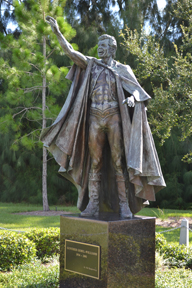
The Gunther Gebel-Williams Statue
In
the park area adjoining the Depot there is also a statue of Gunther
Gebel-Williams, said to be world’s greatest lion tamer. At first it
seems disconnected amidst this theme of railroading, but it’s a tribute
to the circus that contributed so much to the city. Gebel-Williams, it
is claimed, was “the man who changed the American circus forever,” and
of course was the ”adopted” favorite son of Venice.
Besides
the historical aspect of the Depot it anchors the southern end of the
Legacy Trail, a 10-mile long paved path for joggers, walkers, roller
bladders, and cyclists following the route of the old rail bed. Yet
the Legacy is only half of Sarasota County’s largest public recreational
project. The other half is the Venetian Waterway Park trail, anchored
on the north by the Depot and paralleling the Intracoastal Waterway for
additional 10 miles.
The
renovation project added another 40 feet of covered waiting area to the
south side to accommodate the SCAT bus service using the Depot as a
hub. So, you see, there are numerous ways you can come and marvel at
this place; walk, cycle, drive, or arrive by public transit, and no
method will alter your appreciation. The Historical Society claims the
park is a work in progress, but one wonders how much better it can be.
The historical Venice Depot is located at 303 East Venice Avenue. Beginning
November thru May free docent tours are conducted from 10 am to 3pm and
on Saturday throughout the year from 10 am to 1 pm. For upcoming
speakers and programs, call 941-412-0151, email venicehistory@comcast.net or go to www.Venicehistory.com.
|

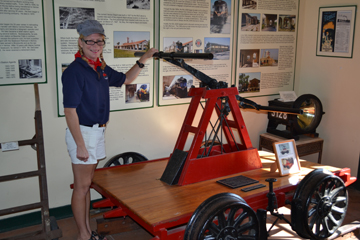 Jeanne M. Kelly, Historic Venice Depot docent
Jeanne M. Kelly, Historic Venice Depot docent 


